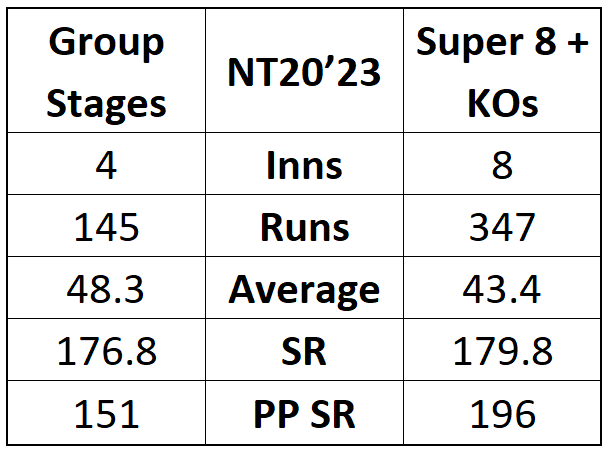
How Sahibzada Farhan Learned to Stop Worrying and Love the Powerplay
Sahibzada Farhan made his T20I debut in a low-key Tri-Series Final vs Australia in Zimbabwe in 2018. He took two catches and then was stumped off a wide. Hussain Talat would follow shortly after. Pakistan managed to win the game thanks to Fakhar being Fakhar and then Asif finishing the game off at the end. Sahibzada, Talat, and Asif were all beneficiaries of Islamabad United’s record-breaking title-winning season in 2018. Sahibzada had scored 29 off 18 in the Qualifier vs. Karachi and then 44 off 33 in the Final vs. Peshawar, both times playing second fiddle to a rampant Luke Ronchi.
In the space of six months, Sahibzada, in his debut season, had seen two T20 openers define competitions and win their team trophies. But it took five years for the lessons of those competitions to truly hit home for him.
For five years, he gave the old-fashioned way a try. Most of the time, the old-fashioned way works on the selectors. They see someone topping the run charts, and their first inclination is to pick him first and ask questions later. They do not usually let stuff like batting position or team role get in the way of sheer run weight. The problem for Farhan was that two people were old-fashioning better than he ever could, and they were not moving any time soon, with the rest of the lineup picked to allow them to go as old-fashioned as their heart desired with virtually no consequences.
The second problem for Farhan was that he was born in the wrong generation. If he churned out his 2021-22 NT20 numbers in the 2009-15 era of the Pakistan T20 team, he would have been billed as the most important member of the team because that is just the way T20 cricket was judged those days. With the advent of PSL, NT20 numbers are usually not enough; you need to prove you can do it at a higher level. And that brings us to his third problem. You can not prove yourself in the PSL if you do not get picked. Teams want openers that can define their innings, set the tone at the start, or be reliable enough to stick around for the middle order to explode. The moment they can not find someone who can do that locally, they go international because, as a T20 team, you can compromise on your middle order, your bowling, and your fielding, but you cannot compromise on your openers.
Sahibzada needed to break into PSL, and so far, the conventional way had only gotten him a few games in the lowest-ranked team in the competition.
His two NT20 season numbers of 2021 and 2022 are virtually identical. Farhan had found a method that worked, and it was yielding him success. It was a method that was guaranteeing him runs and a regular place in the best domestic team. The regular place is an important point because in the years preceding these seasons and even during the 2021 season, he was not guaranteed a set batting position and place in the team due to the availability of national team players.
The old-fashioned way may not have got Farhan to the destination that he hoped to reach, but it did allow him to secure his place and the freedom to change his game in the subsequent season with the weight of past performances, meaning that he would be given a longer rope to succeed if required. He even found himself handed the role of captaincy for some games.
To put plans in place is all well and good, but when a cricketer walks out to bat, he will slip into a trance and attempt to bat like he always has. To change the way you play after playing one way for your entire career requires constant reminders and a commitment to continue to play that way for better or worse. The NT20 this year was virtually split into two competitions with the 18 team group stages that had lesser ranked teams going up against behemoths like Sahibzada’s Peshawar. To dominate those bowlers and stick to your plan of being attacking is a relatively easy task; the real test comes with the step-up in quality in the Super 8s. Are you still committed, or do you go back to what is safe?
Sahibzada was committed.
Powerplay maximization is not a new concept. It is just that news travels slowly and falls on deaf ears. But those who are searching on different frequencies eventually dial into it. Because why should you not try to loft the ball over the infield for a virtually guaranteed boundary with the right placement? Clearing a 30-yard line at the start with wickets in hand and a manageable run rate requirement is easier than trying to clear an 80-meter boundary at the end. Powerplay maximization is what those teachers used to preach at the start of the school term that none of us actually listened to. “Do a little from now every day instead of binge studying at the end,” but we wanted to get “set.” The studying is a problem for the you six months from now – he will probably figure it out.
Farhan’s Powerplay acceleration meant that he turned his 40-ball 50s, which most Pakistani T20 fans will be familiar with, into 30-ball 50s while ensuring that if he were to get dismissed before he could take full toll at the death, his team would still have a relatively useful 20-ball 30.
He was always a good player of spin and was always quite proficient in attacking them, but even in that, he has taken recognition of his positive match-up and looked to take down off-spin, which yielded him 44 runs off 21 balls. It is thanks to this increased intent and match-up recognition that his middle-over numbers look even better than in previous seasons.
Sahibzada, out of frustration more than anything else, took a leap of faith, and his gamble has paid off. He has a virtually guaranteed starting spot in the XI of the team that has won the last two PSLs and now has been rewarded with a T20 call up. The only question that remains is: Will he continue to be committed to his new method?












Leave a Reply